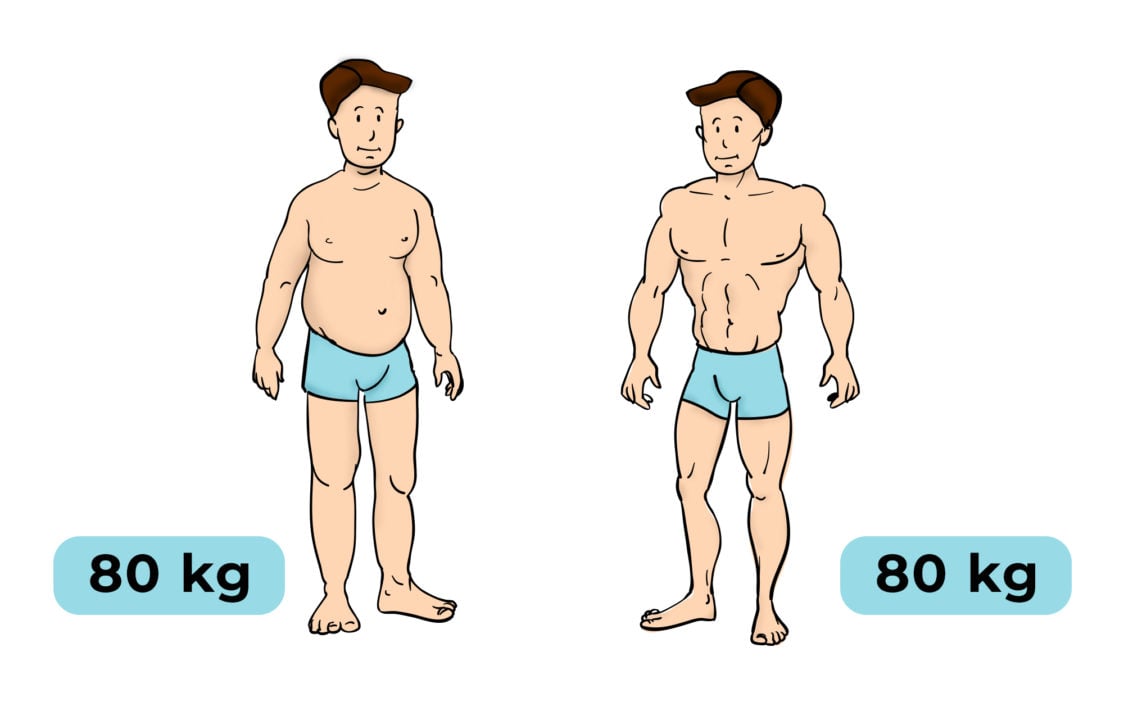Table of Contents
Did you know that a slim body does not automatically mean a healthy body? After all, body weight and BMI are not the only body parameters that affect health. The percentage of fat in the body and the amount of muscle mass also play an important role, as evidenced by thin obesity. In this case, it is an unfavourable body composition when there is too much fat and not enough muscle. Unlike normal overweight or obese people, however, people with thin obesity have a normal weight. Yet similar health risks are associated with it. It is so important not to underestimate this condition and to treat it early.
What does skinny fat or thin fat obesity mean?
Everyone has probably seen a picture of a person before and after they started exercising and generally changed their lifestyle. Surprisingly, the same or similar weight often appears under these pictures. But when we look at the athletic physique in more detail, we get the feeling that these are two different people. The one on the left doesn’t look very fit, and their physique is not solid at first glance. Whereas after the transformation, a person might have the same weight but visible muscles, a narrower waist and overall look kind of fit. What’s behind that? A simple change in body composition. That person lost fat, gained muscle, and achieved a healthier and more attractive body composition.
Body weight is not the only indicator one should be looking at. Thin obesity is a prime example that a normal BMI is not a 100% guarantee of a healthy body. The phenomenon is thus characterised by excessive body fat despite a normal body weight. The opposite example is strength athletes, who have a high BMI, little fat but a lot of muscle. [1]
To learn more about BMI, how it is calculated and what it is used for, read our article What is a BMI Calculator and Is It Reliable?

How do you recognise thin obesity?
At present, there are no clear criteria for diagnosing thin obesity. However, it is most often assessed by determining BMI and body fat percentage. In the case of BMI, experts usually agree on a range of 18.5 – 24.9 kg/m2, which represents a normal weight range.
But this is not true for the body fat limits. There, the criteria vary across studies. Some have considered risk levels to be higher than 20% body fat for men and 30% for women, while other papers have used ranges of more than 25% for men and 35% for women. Thus, we have to wait for official standards for thin obesity to be established. In any case, these are the values that most experts believe form the boundary between normal fat percentage and being overweight. [1-2]
In addition, people with thin obesity are also characterised by a low proportion of muscle mass, which can also have negative consequences. [1-2]
To measure body composition, bioimpedance scales (changes in the electrical conductivity of different body tissues) or densitometry, also known as DEXA, are most commonly used and are based on the principle of the different conductivity of X-ray light through tissues. Although the latter is considered the most accurate, for this purpose it is sufficient to weigh yourself on a bioimpedance balance such as InBody, Tanita, Omron or Tesla Smart. This type of scale can also be found in a number of fitness centres. Thanks to this scale we can obtain a lot of interesting information about ourselves, including the amount of muscle and bone mass, fat or body water. [3]

What dangers hide underneath thin obesity?
If one has more fat than is healthy, it probably won’t save them even if the charts say their weight is within the normal range. In fact, more fat is associated with a higher risk of a number of diseases. In this respect, one may experience comparable health complications to those faced by overweight and obese people. This risk is more evident in these people than in a person of normal weight, who would not have thought of it at first hand. And this is where the greatest danger of thin obesity lies. It’s not immediately visible, and a person can live under the misconception that everything is fine. [4]
What are the health risks of thin obesity?
A high body fat percentage and, conversely, a lack of muscle mass is a threat to the body for several reasons. Studies that have looked at the health status of people with thin obesity, or normal weight obesity, have revealed a number of risks. Compared to individuals with a lower percentage of fat, they were more likely to have:
- high blood pressure
- Dyslipidaemia (fat metabolism disorder)
- increased cholesterol levels
- heart disease
- Insulin resistance (reduced sensitivity to insulin), which can lead to type 2 diabetes [5-7]
These are serious health complications that can significantly impair your quality of life. So it is absolutely crucial to identify thin obesity early and start addressing it.
What can cause a lack of muscle?
Lack of muscle, which is also typical of thin obesity, also has a number of negative consequences and reduces your overall quality of life.
- The human body needs muscle to function properly and overall a person gets weaker as they lose muscle. This can manifest itself in everyday life, where one may have difficulty, for example, lifting heavy shopping, doing household chores or moving furniture.
- At the same time, one becomes more susceptible to fractures and injuries to bones, joints, ligaments and other parts of the musculoskeletal system. This is especially typical in older age, when the amount of muscle mass in the body naturally decreases.
- A decrease in muscle mass can also cause a slower metabolism (fewer calories burned), as these are highly metabolically active parts of the body.
- A low muscle mass also poses a metabolic risk to the body because it is the main reservoir of amino acids, which are the main building blocks of the body. It needs amino acids to regenerate and repair other tissues and organs.
- Last but not least, muscles play an important role in the appearance of an individual’s physique, which can look less attractive compared to a higher proportion of active mass. In fact, muscles firm the body and make nice curves. [8-9]
If you want to boost muscle growth and don’t know how to do it, read our article What to Eat and How to Exercise to Finally Put on Muscle?

What are the most common causes of thin obesity?
There are several reasons behind the development of thin obesity and it is often not easy to pinpoint just one culprit. Usually it is a combination of several factors. For example, someone is born with a genetic predisposition to store more fat in the body. This can also be influenced by body’s hormonal environment. However, these circumstances are typically not so influential that nothing can be done about them. But what a person decides to a large extent is their lifestyle, of which diet, exercise and sleep are important factors. [10]
1. Inappropriate diet
The problem can arise when one doesn’t follow the rules of healthy eating and eat whatever they feel like. This means that the staples of their diet are fast food, pizza and sweets washed down with a Coke. These foods may be high in energy, but they don’t provide the body with many vitamins, minerals, fibre and other health-giving nutrients. Not to mention that they typically lack quality protein, which is needed for muscle growth and immunity. So instead of a healthy body, such lifestyle builds the perfect environment for fat tissue to grow. [10-11]
Start taking baby steps towards a healthier diet with the advice in our article What Is a Healthy Diet and How to Learn to Eat Healthily?
2. Excessive dieting
The endless cycle of drastic diets, detoxes and starvation is not good for body composition either. This way you can lose weight relatively quickly, but with the lost kilos you will lose a lot of muscle mass. If you then return to normal diet and replace vegetables with usual diet, the weight you’ve lost can come back in a flash. As a result, you may end up with even more fat and less muscle than before you started the diet. If this is repeated regularly, you can paradoxically progress to thin obesity. [12]
If you want to try a detox, which is in turn beneficial for the body, you can find tips on how to do it in our article Detoxification and Cleansing of the Body: What Is It and How to Detoxify Your Body Naturally?
3. Insufficient or inappropriate physical activity
The way you move undoubtedly has an impact on your body composition and overall appearance. You don’t have to be a couch potato to be affected by obesity. It is enough if you don’t put too much strain on muscles and skip workouts.
Muscle mass tends to weaken and shrink without a big regular boost. Our body is a good ‘housekeeper’ and can simply get rid of the energy-consuming tissue that you don’t use anyway. Why should it nourish it and keep it working? The same problem can arise with people who think they can get a firm body with nice curves and generally overdo it with cardio. This is because with prolonged exercise, the body can start burning muscle mass and extracting energy from it, which then results in its gradual loss. When this is combined with a low energy intake and lack of protein, muscle loss can accelerate. [10, 13]
In the case you’re looking for motivation to exercise and wondering what benefits you can get from it, read our article How Does Your Body and Mind Change When You Begin Exercising and Eating Healthily?

4. Lack of sleep, stress and bad habits
It’s not just diet and exercise that determine how much fat and muscle a person has in the body. Other areas of a lifestyle also play a part. For example, lack of sleep or excessive (poorly managed) stress can negatively affect the levels of hormones that regulate appetite, fat burning or muscle growth. Another trigger for thin obesity can be high alcohol intake or smoking. Studies have confirmed that these unhealthy habits are associated with increased body fat deposition and muscle loss. [11, 14]
If you are looking for tips on how to fall asleep more easily, read our article How to Fall Asleep Quickly? Try These Simple Tips for a Better Sleep.
5. The cult of thinness
In our modern society, it is still true that being thin automatically equals healthy. Unfortunately, nothing else is taken into account in this respect, least of all whether a person has become slim using the right methods. Unfortunately, it is still the case that when a person loses weight and fits into a size XS, everyone applauds, regardless of whether it was due to drastic dieting, stress or never-ending workouts. People also often get too fixated on their weigh because doctors and other experts ask about it. But then they don’t think about whether they have too much fat and not enough muscle. Especially for women, this can be compounded by a fear of strength training. Women are afraid that they will get fat and heavy because of bigger muscles.
You can also read about why it’s not good to fixate only on body weight in our article Why the Scale Shows You a Higher Number and It’s Not Fat.
You might be interested in these products:
How to address thin obesity?
If you’ve had your body composition measured and found that you have too much fat and not enough muscle, don’t despair. It’s never too late to start addressing this. When it comes to body modification, you first need to come to terms with the fact that it’s a long haul. Especially if you want lasting and sustainable results. This is not some thirty-day challenge after which you will go back to your original routine. The changes you make in this process should ideally become part of your lifestyle.
Compared to conventional weight loss, the approach is slightly different. You want to lose fat and build active muscle mass at the same time, which is usually not possible without weight gain. So first you should focus on building muscle and after a few months you can start the bulking phase. If you devote enough time to this, you will reap the rewards in the form of a healthier, more functional and attractive body.
1. Set your caloric intake for muscle growth
- Muscle growth is best supported by increasing energy intake by 10 – 20% over the maintenance intake (the amount of calories needed to maintain current weight). For most people, this equates to adding approximately 250 calories per day.
- To help you set your energy intake, the Online Energy Intake Calculator calculates your calorie and macronutrient (protein, carbohydrate, fat) intake based on your body parameters and daily activities.
- You should also keep an eye on your protein intake, which should fall within the range of 1.4 – 2g per kg of body weight.
- When preparing a diet, you should not only follow the calculated numbers, but also the rules of a healthy diet. For example, a healthy plate, which is useful for estimating the portion size of protein, carbohydrates and fat in one meal, can help. [16]
For detailed instructions on how to create a diet, see our article How to Calculate Energy and Nutrient Intake for Weight Loss or Muscle Gain?

2. Start strength training
Muscles need a stimulus for their growth, which is best achieved by strength training. This doesn’t have to include exercising with weights only, on machines or with other loads at the gym. You can start by exercising with your own weight, with resistance bands or a suspension weight system. The main thing is to learn to exercise correctly and increase the load gradually.
- Strength training 2 – 4 times a week.
- If you exercise twice a week, you can add upper and lower body exercises to each workout.
- With a frequency of four workouts, you can divide the workouts into individual parts, trying to exercise each body part at least two times a week.
- The stronger you are, the easier the training load becomes, which can result in a stagnation of muscle growth. For this reason, it is important to gradually increase the difficulty of exercises, adding more repetitions, sets or raising the intensity.
- You can go jogging or do other sports, but endurance training should occur less frequently than strength training. [16]
If you want to learn more about how to put on muscle, you can find more valuable advice in our article 10 Tips for Healthy Weight Gain.

3. Focus more on fat loss over a period of time
With healthy weight gain, when the amount of muscle mass in the body increases, there is often a natural decrease in body fat percentage. However, if you find out that your values are still above the lower limit of the norm (above 20% for men and above 30% for women), you will need to go to cutting phase. The main transition will be to reduce caloric intake.
- After the weight gain phase, it is advisable to switch to a maintenance regime first, at least for a few months, and then start losing weight.
- When losing weight, you need to reduce your caloric intake to well below your caloric output and get into a caloric deficit.
- Initially, calorie intake is reduced by 15 – 20% compared to the maintenance regime. Again, the Online Energy Intake Calculator will help with the calculation.
- Strive to maintain your protein intake at 1.4 – 2 g per kg of body weight.
- You should continue to exercise at least two times a week to maintain maximum muscle mass.
- You can also incorporate cardio training more frequently to increase energy expenditure. [15, 17-18]
4. Remember about body regeneration
You don’t have to wallow at home in front of the TV, but plan at least 1-2 days a week without heavy training. Feel free to engage in an activity that you know is relaxing for you. For some, that’s a walk, a stretch, or a slow run. Rest is an important part of your overall effort. It is the time in which your body replenishes its energy (stored carbohydrate glycogen) and fluid stores after a workout. Likewise, your muscles need time to recover so that they can handle an even higher load than last time at the next workout. You can also support recovery with effective massage accessory such as a massage roller or gun. [19]

5. Track your progress
To stay on track, stay motivated and get feedback on your efforts, schedule a check-in measurement every two weeks. Measure your body circumference, weigh yourself and ideally go to InBody once a month to have your muscle and fat measured. You can also take progress photos and compare them to each other.
When measuring progress, it is important to weigh and measure under the same, or at least similar, conditions. This means measuring yourself at the same time of day, in similar clothes and taking into account whether you have eaten or used the toilet before. For women, the ongoing phase of their menstrual cycle is also taken into account. This can really mess with your weight.
6. Focus on better sleep and stress management
If you have a perfectly balanced workout and diet, but don’t give your body enough rest and sleep, the results will probably not be what you expect. This is due to several factors. For example, insufficient sleep can affect hormone levels (↑grelin – hunger hormone, ↓leptin – satiety hormone), which can make you crave more and choose less appropriate types of food. Overall, it appears that sleep deprivation is associated with a higher incidence of failure in body transformation. For these reasons, try to support your overall efforts with 7-9 hours of sleep. [20]
You should also take proper care of your mental health and manage stress better. Something different can help each of us in this respect. Good techniques include breathing exercises, a walk in the fresh air, reading a book, getting a massage or spending time with friends or family.
Sleep can affect not only weight loss, but also sports performance and other important aspects of your life. You can read more about the importance of sleep in our article What Happens to Your Body When You Don’t Get Enough Sleep?

7. Be consistent and patient
When completely changing your physique, you have to accept that it may not work as quickly as you would like. Sometimes you may find that instead of taking a step forward, you take two steps back. But that’s part of the process. The important thing is not to lose direction and to keep going despite any deviations from your diet or training plan. If you’re patient enough, over time you’ll find that you don’t actually have to think about whether to exercise or not and it just becomes a habit. Then it will be much easier to maintain the results, and even improve on them.
If you’re wondering how to incorporate exercise into your daily routine, check out our article How to Turn Exercise Into a Habit in 8 Easy Steps.
What should you remember?
Thin obesity is proof that a normal weight does not automatically mean a healthy body. Excess body fat combined with a lack of muscle mass is a ticking time bomb. It is associated with a risk of various diseases and, in later life, an overall poorer quality of life. Therefore, it is important to detect thin obesity early and start doing something about it as soon as possible.
The most important means to help change your body composition for the better include a healthy diet, strength training, enough sleep, rest, mental health care and patience. You need to persevere and start changing your lifestyle step by step. The reward will be a healthier body and the bonus will be a more attractive figure.
Did you find this article useful? If so, please share it with your friends and share valuable information about thin fat obesity.
[1] Franco, L. P., Morais, C. C., & Cominetti, C. Normal-weight obesity syndrome: Diagnosis, prevalence, and clinical implications. – https://doi.org/10.1093/nutrit/nuw019
[2] When Thin Is Fat—If Not Managed, Normal Weight Obesity Can Cause Health Issues. – https://www.todaysdietitian.com/newarchives/011211p14.shtml
[3] Měření tělesného složení. – https://www.fsps.muni.cz/emuni/data/reader/book-18/08.html
[4] Čuta, M., Bařicová, K., Černý, D., & Sochor, ONormal-weight obesity frequency in the Central European urban adult female population of Brno, Czech Republic. – https://doi.org/10.21101/cejph.a5133
[5] Mohammadian Khonsari, N., Khashayar, P., Shahrestanaki, E., Kelishadi, R., Mohammadpoor Nami, S., Heidari-Beni, M., Esmaeili Abdar, Z., Tabatabaei-Malazy, O., & Qorbani, M. Normal Weight Obesity and Cardiometabolic Risk Factors: A Systematic Review and Meta-Analysis. – https://www.frontiersin.org/articles/10.3389/fendo.2022.857930
[6] Romero-Corral, A., Somers, V. K., Sierra-Johnson, J., Korenfeld, Y., Boarin, S., Korinek, J., Jensen, M. D., Parati, G., & Lopez-Jimenez, F. Normal weight obesity: A risk factor for cardiometabolic dysregulation and cardiovascular mortality. – https://doi.org/10.1093/eurheartj/ehp487
[7] Madeira, F. B., Silva, A. A., Veloso, H. F., Goldani, M. Z., Kac, G., Cardoso, V. C., Bettiol, H., & Barbieri, M. A. Normal Weight Obesity Is Associated with Metabolic Syndrome and Insulin Resistance in Young Adults from a Middle-Income Country. – https://doi.org/10.1371/journal.pone.0060673
[8] Więch, P., Chmiel, Z., Bazaliński, D., Sobolewski, M., & Sałacińska, I. Body Composition and Selected Nutritional Indicators in Healthy Adults—A Cross-Sectional Study. – https://doi.org/10.1177/21649561211021794
[9] Wolfe, R. R. The underappreciated role of muscle in health and disease. – https://doi.org/10.1093/ajcn/84.3.475
[10] Kapoor, N. Thin Fat Obesity: The Tropical Phenotype of Obesity. In K. R. Feingold, B. Anawalt, A. Boyce, G. Chrousos, W. W. de Herder, K. Dhatariya, K. Dungan, J. M. Hershman, J. Hofland, S. Kalra, G. Kaltsas, C. Koch, P. Kopp, M. Korbonits, C. S. Kovacs, W. Kuohung, B. Laferrère, M. Levy, E. A. McGee, … D. P. – http://www.ncbi.nlm.nih.gov/books/NBK568563/
[11] Maitiniyazi, G., Chen, Y., Qiu, Y.-Y., Xie, Z.-X., He, J.-Y., & Xia, S.-F. Characteristics of Body Composition and Lifestyle in Chinese University Students with Normal-Weight Obesity: A Cross-Sectional Study. – https://doi.org/10.2147/DMSO.S325115
[12] Compass Nutrition. Fad Diets. – https://www.compassnutrition.com/healthy-regards/2016/1/31/r386jjn8n0t2534t4uqnfmcnxsaazr
[13] Sartori, R., Romanello, V., & Sandri, M. Mechanisms of muscle atrophy and hypertrophy: Implications in health and disease. – https://doi.org/10.1038/s41467-020-20123-1
[14] Štefan, L., Čule, M., Milinović, I., Juranko, D., & Sporiš, G. The Relationship between Lifestyle Factors and Body Compositionin Young Adults. International – https://doi.org/10.3390/ijerph14080893
[15] Aragon, A. A., Schoenfeld, B. J., Wildman, R., Kleiner, S., VanDusseldorp, T., Taylor, L., Earnest, C. P., Arciero, P. J., Wilborn, C., Kalman, D. S., Stout, J. R., Willoughby, D. S., Campbell, B., Arent, S. M., Bannock, L., Smith-Ryan, A. E., & Antonio, J.International society of sports nutrition position stand: Diets and body composition. – https://doi.org/10.1186/s12970-017-0174-y
[16] Krzysztofik, M., Wilk, M., Wojdała, G., & Gołaś, Maximizing Muscle Hypertrophy: A Systematic Review of Advanced Resistance Training Techniques and Methods. – https://doi.org/10.3390/ijerph16244897
[17] Human Kinetics. Normal ranges of body weight and body fat. – https://us.humankinetics.com/blogs/excerpt/normal-ranges-of-body-weight-and-body-fat
[18] Calorie deficit for weight loss: How it works, tips, and safety. – https://www.medicalnewstoday.com/articles/calorie-deficit
[19] Ball, D. Rest days are important for fitness – here’s why, according to science. – http://theconversation.com/rest-days-are-important-for-fitness-heres-why-according-to-science-143875
[20] Conversation, E. S. and I. W., The. Why Sleep Is So Important For Losing Weight, According to Researchers. – https://www.sciencealert.com/a-full-night-s-sleep-appears-to-be-a-key-part-of-healthy-weight-loss


Add a comment